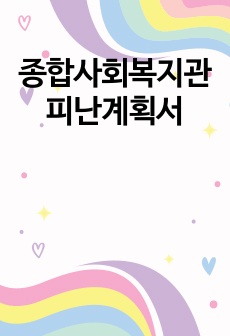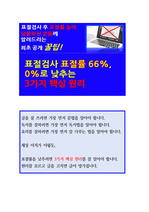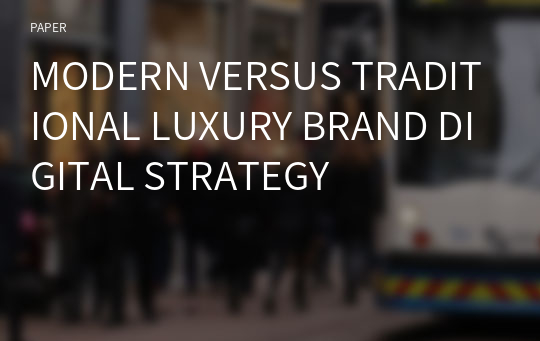MODERN VERSUS TRADITIONAL LUXURY BRAND DIGITAL STRATEGY
* 본 문서는 배포용으로 복사 및 편집이 불가합니다.
서지정보
ㆍ발행기관 : 글로벌지식마케팅경영학회(GFMC)
ㆍ수록지정보 : Global Marketing Conference
ㆍ저자명 : Kirsten L. Cowan, Alena Kostyk
ㆍ저자명 : Kirsten L. Cowan, Alena Kostyk
영어 초록
IntroductionWith most consumers in developed countries actively using Internet in their daily lives (International Telecommunication Union, 2017), and billions of monthly active social media users (Facebook, 2017; Instagram, 2017), businesses across the globe work to ensure their efficient representation in the online environment. For luxury brands, digitalization poses unique challenges. While some luxury brands fully embrace the digital environment, whether through designing memes for their social media campaigns (Gucci, 2018), or through selling their luxury products via online channels (Vacheron Constantin, 2018), other luxury brands avoid digitalization. Some marketers suggest that “digitalization of luxury brands” is somewhat paradoxical, since customers of luxury brands expect exclusive access, insider knowledge, and more personalized, intimate service than online environment can offer (Deloitte Touche Tohmatsu Limited, 2015; Hennings, Wiedmann, and Klarmann, 2012; Popomaronis, 2017). Considering that “one size” does not fit all in marketing, could it be the case that digital presence has favorable impact on some luxury brands, but not on others? Brand personality, culture and values of luxury brands can work to create a traditional, or a more modern, brand image (Azoulay & Kapferer, 2003; Madhavaram, Badrinarayanan, & McDonald, 2005). It seems reasonable to assume that more modern luxury brands are expected to modernize, even in a digital capacity, while traditional luxury brands are expected to be resilient to change. In other words, digitalization might be perceived differently by customers of traditional luxury brands versus modern luxury brands. However, luxury brand literature is silent as to how these brands should engage audiences online. The primary goal of this paper is to determine whether digital presence leads to differential consumer outcomes depending on the luxury brand identity.
Theoretical Development
It is universally accepted that the online environment is one of the key factors impacting consumer outcomes in our digital age (Darley, Blankson, & Luethge, 2010). Specifically, brand website quality, interface, experience and website satisfaction all have a strong influence on the consumer decision process, and determine how consumers engage with and obtain knowledge of a brand (see Darley et al., 2010 for a review). Moreover, navigation and convenience of the brand website environment were found to be important predictors of consumers’ attitudes (Childers, Carr, Peck, & Carson, 2001). In fact, when it comes to evaluating brands and their websites, consumers are driven by three factors: website functionality (e.g., navigation), psychological factors (e.g., trust and feelings of reliability/professionalism), and content (e.g., website design) (Constantinides, 2004). At the same time, these three driving factors in website evaluation (i.e., functionality, psychological factors, and content) help build the brand identity, and create a specific brand image through brand presentation style, and the relationships created with customers (Nandan, 2005). A strong component of brand identity is brand personality. Using Aaker’s (1997) brand personality dimensions as a starting point, Heine (2009) developed a luxury brand personality scale, identifying the following traits: modernity, eccentricity, opulence, elitism, and strength. The first trait, modernity, refers to the temporal perspective of the brand, ranging from modern to traditional. ”Traditional” can mean conservative, classic, and old-fashioned, yet luxury brand positioning is often based on tradition, which results in low modernity (Esteve and Hieu-Dess, 2005; Mutscheller, 1992; Vernier and Ghewy, 2006; Vickers and Renand, 2003; Vigneron and Johnson, 2004). The concept of a “modern brand,” on the other hand, elicits associations such as contemporary, trendy, and progressive. For luxury brands, while Donna Karan New York would identify as a modern brand, Hermes provides an example of the traditional brand. Past research indicates that modern brands are more symbolic, embody conspicuousness, and do not require luxury knowledge. Furthermore, modern brands are often deemed more exciting (Aaker, 1997) and creative (Roux, Tafani, and Vigneron, 2017). In contrast, a traditional brand requires craftsmanship, represents aesthetic possession, and requires knowledge (Pitt, Berthon, Parent, and Berthon, 2001). While Kapferer (1998) considers that tradition and modernity are part of luxury brand identity, and thus strategy, only recent evidence demonstrates that luxury brand image can influence consumer evaluations and decision making (Roux et al., 2017). We suggest that luxury brand identity should impact the digitalization strategy of the luxury brands. First, even though past research suggests that e-commerce and use of social media bodes well for luxury brand strategy (Godey et al, 2016; Lee and Walkins, 2016), we argue that for modern (vs. traditional) luxury brands, digitalization and social media presence is viewed more negatively. This is due to the fact that modern brands are more symbolic, that is a sign of affluence (Pitt et al., 2001), and linked more closely to the trait of exclusivity (Roux et al., 2017). When negative attitudes of the modern luxury brand consumers arise, they will result in lower evaluations of the brand digitalization efforts (e.g., brand website). Formally, H1: Exposure (vs. no exposure) to the brand’s social media page will lead to lower (vs. higher) brand website evaluations for the consumers of a modern (vs. traditional) luxury brand. Given that consumers can express love for brands and designate status to brands, their overall relationships with a brand can influence brand website evaluations. However, consumers could attribute higher or lower value to a brand’s identity in the online environment, thereby determining the success or failure of luxury brand digital strategy (Quach and Thaichon, 2017). More specifically, consumers might perceive brand website to be an integral part of a modern brand’s image, and might not see a website as a critical component of a traditional brand’s image. In other words, a website of a modern brand might be subject of higher scrutiny than that of a traditional brand, and thus might be more dependent on the overall consumer attitudes towards the brand. Therefore, we propose that brand love can attenuate the negative influence of digitalization on website evaluations for a modern brand. As such, H2: For a modern luxury brand, high (vs. low) brand love will increase (vs. decrease) website evaluations. No such relationship exists for a traditional luxury brand.
Study 1
One hundred and forty-six French participants were recruited on social media (Mage = 28; 71.9% female) to participate in a survey conducted in French about luxury brands. Participants were randomly assigned to one of four conditions in a 2 (Luxury brand: modern vs. traditional) x 2 (Social media page: shown vs. not) between-subjects experimental design. After viewing the website for either the brand identified during the pretests as traditional (Hermes) or modern (Celine), participants in the “social media page: shown” condition viewed the target brand’s Instagram page. Participants in “social media page: not shown” condition immediately proceeded to the study questionnaire. Following this, all participants responded to the questionnaire measuring the dependent variable, Website evaluations, on a 3-item 7-point scale (“How would you rate this website on the following features: design, navigation, and professionalism”, 1 - very negative and 7 - very positive; α = .94; Constantinides, 2004). Next, participants responded to two covariates, including two 7-point Likert-type items to capture Luxury brand knowledge (e.g., “I know more about luxury brands than most other people”; r = .96; p < .001; Mueller, Francis, & Lockshin, 2008), and one item measuring Luxury shopping habits (“How often do you buy luxury goods?”, 1 - more than once a month and 7 - never). Social media usage, as it pertains to this study in particular, was measured as a covariate on a one-item scale (“How often do you use social media?”, 1 - several times a day, 4 - at least once per month). Lastly, demographics were captured. An ANCOVA with the Luxury brand (0 - traditional brand, 1 - modern brand) and the Social media page (0 - not shown, 1 - shown) as the independent variables, Luxury brand knowledge, Luxury shopping habits, and Social media usage as covariates, and Website evaluations as the dependent variable yielded a significant 2-way interaction (F(1, 144) = 3.91; p = .05), driven by main effects of Luxury shopping habits (F(1, 144) = 5.28; p = .02) and Social media usage (F(1, 144) = 6.75; p = .01). The means revealed directional support that the traditional brand website was evaluated more favorably (M = 5.59) than that of the modern luxury brand (M = 5.38). Planned contrasts revealed that for those who saw the social media page, the Website evaluations were higher for the traditional brand (M = 5.56, SD = 1.48) than the modern brand (M = 5.10, SD = 1.88; F(1, 144) = 1.76; p = .06). For those who did not see the social media page, Website evaluations did not differ for the modern (M = 5.68, SD = 1.52) or traditional luxury brand (M = 5.63, SD = 1.53; F(1, 144) < 1). Moreover, for the traditional brand, the social media page did not influence Website evaluations (M = 5.56, SD = 1.48 vs. M = 5.63, SD = 1.53 for shown vs. not shown; F(1, 144) < 1). On the other hand, for the modern brand, Website evaluations were lower for those who saw the social media page (M = 5.10, SD = 1.88) versus did not see the social media page (M = 5.68, SD = 1.52 F(1, 144) = 2.61; p = .02). Thus, the modern brand was more influenced by digital strategies than the traditional brand, such that for the traditional brand, viewing the social media page did not influence the website evaluations. In contrast, viewing the Instagram page of the modern luxury brand had a negative influence on luxury website evaluations. The modern brand website, specifically, was viewed as less aesthetically pleasing, and less professional, after viewing the brand’s Instagram page. We speculate that this is because the luxury brand was seen as less rare, and special, after viewing its social media page, and these negative associations affected downstream consumer judgments when evaluating the brand website.
Study 2
To formally test hypothesis two, European consumers speaking English were recruited via social media to participate in a study on luxury brands. An experiment using a 2 (Luxury brand: modern vs. traditional) x (Brand love, continuous) between-subjects design was undertaken. The Luxury brand variable was manipulated by exposing participants (N=128; Mage = 21; 60% female; 63% German) to one of the two brands recognized as either more modern (Chanel) or more traditional (Hermes). The dependent variable, Website evaluations, was measured as in study 1 (α = .77). Participants also responded to two 7-point Likert items measuring Brand love (e.g., “I love the brand whose website I just visited”; r = .75; p < .001; Bagozzi, Batra, and Ahuvia, 2014), and two covariates of Luxury brand knowledge (r = .9; p < .001) and Luxury shopping habits. Lastly, demographics were captured. A regression using PROCESS Model 1 with the Luxury brand (0 – traditional brand, 1 – modern brand) and mean-centered Brand love as the independent variables, Luxury brand knowledge and Luxury shopping habits as covariates, and Website evaluations as the dependent variable yielded a significant 2-way interaction (β = .38; t = 1.82; p = .07) driven by a main effect of the Luxury brand, so that the website of the traditional brand was evaluated more favorably (M = 5.85) than that of the modern brand (M = 4.88; β = - .98; t = -3.13; p = .002). Planned contrasts revealed that when Brand love was low, Website evaluations were greater for the traditional brand (M = 5.84) than the modern brand (M = 4.28; β = -1.56; t = -3.86; p = .0002). However, there was no difference in Website evaluations when Brand love was high (M = 5.87 vs. M = 5.47 for traditional vs. modern, respectively; β = -.40; t = -.82; p > .4). Moreover, for the traditional brand, Brand love did not influence Website evaluations (M = 5.85 vs. M = 5.87 for low vs. high brand love; β = .01; t = .08; p >.9). On the other hand, for the modern brand, Brand love had a positive impact on Website evaluations, such that evaluations were higher when Brand love was higher (M = 5.47) versus lower (M = 4.28; β = .39; t = 2.40; p = .018). Thus, luxury brand websites emanating from traditional brands are more widely accepted than those from modern brands. Additionally, these results support hypothesis two that brand love attenuates lower website evaluations for the modern luxury brand while not influential of evaluation of the luxury brand website for traditional brands. Important for the modern luxury brand, brand love should be high for brands pursuing digital strategies.
Conclusion
In sum, the findings from the two experiments indicate that digital techniques employed by traditional luxury brands are more widely accepted than those of modern brands. Specifically, the findings reveal that while social media pages can detract from the evaluations of the modern luxury site, they do not influence the evaluations of the traditional luxury site (study 1). Given that one of the benefits of luxury brands’ sharing of content in a digital environment involves facilitating brand love, it is imperative for modern luxury brands to garner high brand love. After all, brand love increases site evaluations for modern luxury brands (study 2). Using appropriate brand identity interface to communicate brand identity to the brand contacts is important in building brand equity (Madhavaram et al., 2005), especially in the domain of luxury brands, where brand equities amount to billions of dollars (Quach and Thaicon, 2017). Therefore, understanding how best to use digital interfaces is paramount to luxury brand strategy.
참고 자료
없음"Global Marketing Conference"의 다른 논문
 THE ROLES OF GREEN PACKAGING IN UGLY FOOD PURCHASE INTE..22페이지
THE ROLES OF GREEN PACKAGING IN UGLY FOOD PURCHASE INTE..22페이지 THE IMPACT OF INDUCED AWE ON ETHICAL TOURIST BEHAVIORS5페이지
THE IMPACT OF INDUCED AWE ON ETHICAL TOURIST BEHAVIORS5페이지 A BIBLIOMETRIC ANALYSIS OF SPIRITUAL TOURISM RESEARCH15페이지
A BIBLIOMETRIC ANALYSIS OF SPIRITUAL TOURISM RESEARCH15페이지 SOCIAL NETWORK ANALYSIS AND RESPONSE TIME TESTING: CONS..11페이지
SOCIAL NETWORK ANALYSIS AND RESPONSE TIME TESTING: CONS..11페이지 THE EFFECTS OF PARA-SOCIAL INTERACTION ON ONLINE CELEBR..3페이지
THE EFFECTS OF PARA-SOCIAL INTERACTION ON ONLINE CELEBR..3페이지 THE INFLUENCE OF OPINION LEADERS ON DAILY DEALS USER’S ..3페이지
THE INFLUENCE OF OPINION LEADERS ON DAILY DEALS USER’S ..3페이지 HOW IMMERSIVE RETAILING AFFECTS CONSUMERS’ URGE TO BUY:..6페이지
HOW IMMERSIVE RETAILING AFFECTS CONSUMERS’ URGE TO BUY:..6페이지 KEY TO SUPERSTARDOM IN A GLOBALISED MARKET: THE ROLE OF..6페이지
KEY TO SUPERSTARDOM IN A GLOBALISED MARKET: THE ROLE OF..6페이지 A POST-PANDEMIC LOOK AT TOURISTS’ PERCEIVED COOLNESS OF..4페이지
A POST-PANDEMIC LOOK AT TOURISTS’ PERCEIVED COOLNESS OF..4페이지 EXTRACTING OFFLINE RETAIL SHOPPING PATTERNS: OLLABORATI..5페이지
EXTRACTING OFFLINE RETAIL SHOPPING PATTERNS: OLLABORATI..5페이지


























